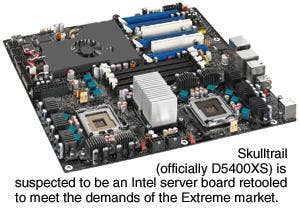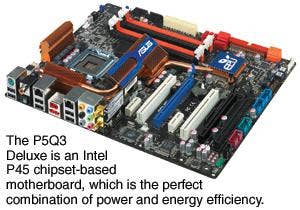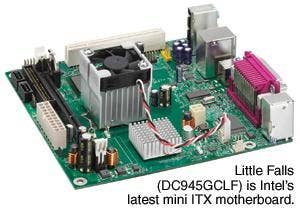MoBos Get Mojo With AsusTek, Intel And GigaByte
Board manufacturers including AsusTek Computer Inc., Taipei, Taiwan, GigaByte Technology Co. Ltd., City of Industry, Calif., and chip giant Intel Corp., Santa Clara, Calif., are on the cusp of a new era of design and engineering—with impressive early results. After examining a series of new boards during the past several months, the CRN Test Center has found an array of significant and new approaches available to system builders that could help shape new strategies.
New 'Green' Possibilities
Whether it's a love for the environment, a desire to cut energy costs or a political statement, the market is pulling the IT industry toward lower-energy computing models. Whatever the reason, manufacturers are feeling the heat to provide more efficiency and board makers haven't been exempt.
Recent lawsuits between GigaByte and Asus over who makes the most energy-efficient motherboard provide additional evidence of how much business is at stake.

During the past few months, the CRN Test Center has evaluated a number of Asus boards with various versions of their EPU (Energy Processing Unit) and AI-Gear software utility. From the third-generation P5E series to the most recent P5Q series, significant energy savings over other boards was very noticeable after some tweaking with AI-Gear. The latest version of the EPU is called the EPU 6-Engine, because it provides power management for the six critical power-consuming components (CPU, memory, HDD, system fan, VGA card and the chipset).
By detecting current loads and moderating the power in realtime, the EPU automatically provides the most appropriate power usage.
Aside from the variety of desktop boards in Asus' P5 series, the company has also expanded its green designs. While manufacturing energy-efficient servers (as other companies do), Asus also has a line of energy-efficient server boards for custom system builders.
Based on Intel's next-generation 45nm Xeon processors, the series, which includes the DSEB-DG and other variations of it, are dual-processor boards, which the company states are optimized for up to 90 percent-plus power efficiency. They claim a savings of 613.2 kilowatt-hours per year when compared with general server boards with 80 percent efficiency.
Next: New Use Models
New Use Models
With the convergence of home entertainment and computing, as well as the ever-expanding gaming community, another area where PCs are rapidly expanding is that of high-definition audio and video. As the prices of large-screen televisions and monitors continue to drop, and the capabilities of the latest games continue to multiply, more and more people are upgrading their systems to be compatible with this latest technology.
Additionally, the demise of the HD-DVD format has allowed users who were on the fence to now safely go ahead and install a Blu-ray drive without the worry over its immediate obsolescence as a casualty of the format war. This, in turn, has caused their availability to rise and their prices to fall.
Motherboard manufacturers were quick to seize this opportunity with a slew of boards embracing the HTPC (Home Theater PC) market. With the release of the 780G chipset from Advanced Micro Devices Inc., Sunnyvale, Calif., Hi-Def was finally available on an integrated graphics processor and within reach at a more affordable price. Because the onboard GPU processes the High Definition codecs, an extremely powerful CPU is not necessary. In addition, the chipset supports Microsoft Corp.'s DirectX 10, as well as OpenGL 2.0, to meet the latest in gaming requirements, all with onboard 7.1 digital audio.

GigaByte's GA-MA78GM-S2H was one of the first motherboards released with the 780G chipset. At a street price of $80 to $90, this board is loaded with all the features that take advantage of what the 780G has to offer, including four DIMM sockets supporting up to 16 GB; integrated High Definition 7.1 Audio; a Gigabit Ethernet connection; PCI Express x16 slot; 5 SATA 3 Gbps connectors supporting RAID 0, 1, 5 and 10; one eSATA 3 Gbps port on the back and four USB ports with support for eight more via the internal headers.
Right on the heels of the 780G, Intel released its 45 series of chipsets. The G45, like the 780G, also has onboard 7.1 digital audio, integrated 1080p High Definition video processed on the GPU and supports DirectX 10 and OpenGL 2.0. Motherboards with the G45 chipset are just now starting to make their way to market, but Intel is adding a twist.
Next: New Form Factors
New Form Factors
Under its own label, Intel is releasing G45 boards based on both the Mini-ITX and Micro-ATX form factor; the DG45FC (aka Flying Creek) and the DG45ID are full-featured G45 motherboards specifically designed with the HTPC builder in mind. Their size allows many stylish ways to add a Media Center PC to a home theater.
Until new standards arrive, Mini-ITX is probably as close to small as the current generation of motherboards is going to get. That doesn't mean that the move toward miniaturization isn't going to continue to happen though. Intel's recently released line of Atom processors pack the power of a full-sized CPU into a die about the size of a penny.
Already popular in so-called Netbooks, such as Asus' Eee PC and Taipei, Taiwan-based Micro-Star International Co. Ltd's. Wind, the Atom promises to shrink computers down to pocket size. Although still in Mini-ITX form factor, Intel's D945GCLF (aka Little Falls) motherboard has an integrated 1.60GHz Atom. While Moore's Law continues to live on, boards and the components that complement them are most surely going to get smaller as the Atom's power continues to grow.
Not to leave the processor-hungry multimedia creators behind, Intel has also created Skulltrail, a dual-socket Extreme Desktop platform that supports up to eight cores. Designed with a focus on advanced digital media creation and editing, it also has specifications that the gaming community has been drooling over since it was first announced.

With LGA771 sockets for the Xeon processors usually used in servers, instead of Intel's current desktop standard, the LGA775, many have speculated that the Skulltrail motherboard (officially called the D5400XS) is really an Intel server board retooled for the Extreme market. Looking at the board, it is easy to understand this assumption, and there is most likely some truth to it.
Still, designers have added enough features to differentiate it from its likely ancestor. Specifically, they've included High Definition 8-channel (7.1) Dolby Home Theater Audio, as well as both Nvidia SLI and ATI CrossFire support. To complement the platform, Intel has also released a new Extreme processor specifically for the board—the QX9775—which is essentially a QX9770 in the LGA771 form.
Beyond The Desktop
Innovation isn't just limited to desktop and server boards. Intel has its sights set on the laptop market too. Earlier this year, the company released details about a new platform going by the name of Rich Creek 2. With expectations of creating a standardized platform as there now is for desktops and servers, the Rich Creek 2 motherboard is planned to be the focal point of a new "ecosystem," where standards-based displays, enclosures and other peripherals will allow system builders to create a truly customized notebook.
Initially, the Rich Creek 2 platform is only going to be available to select Intel partners, but it is still a notable milestone of computing. As more and more component manufacturers embrace the idea, it will soon be possible for custom system builders to compete with the giants. Besides the ease of building the notebooks, support and repairs should also be much easier as standard, off-the-shelf replacement components will eliminate the need for waiting days—or even weeks—for a specific part.
Looking back just a few years, the innovation that has blossomed from the computer industry is incredible. What would have been considered science fiction by many just a decade ago is now almost expected as standard fare. At the forefront of this movement are the motherboard manufacturers. They try to balance the needs and wants of their customers with the latest and greatest that technology has to offer (and usually they are the same thing).
As chip manufacturers continue to push things to the limit, we can only speculate where the future of motherboards is headed. One thing is certain though: White box builders are anxious to see what offerings are in store.